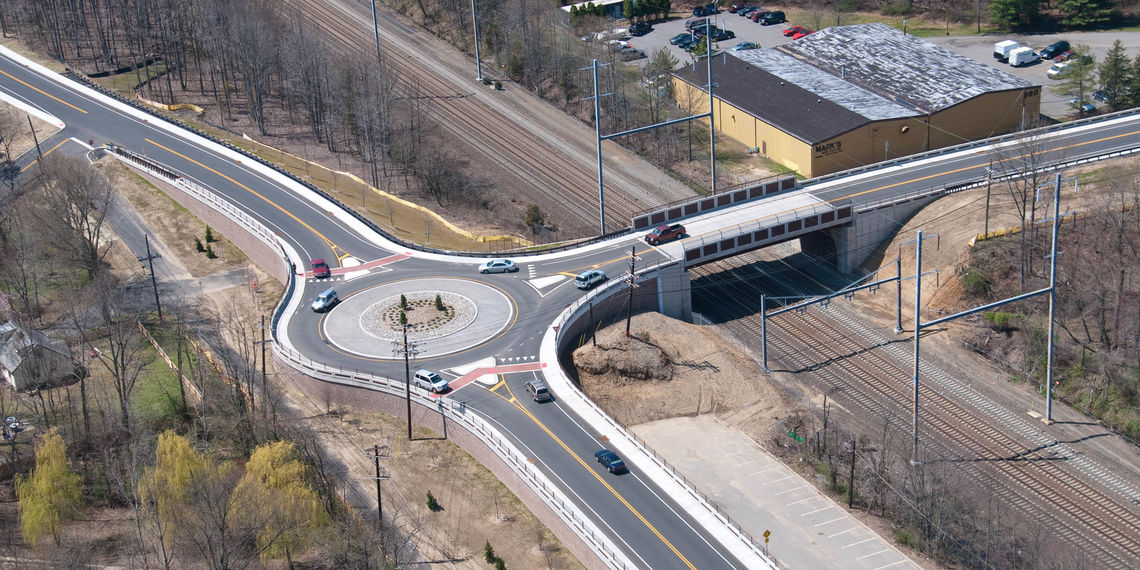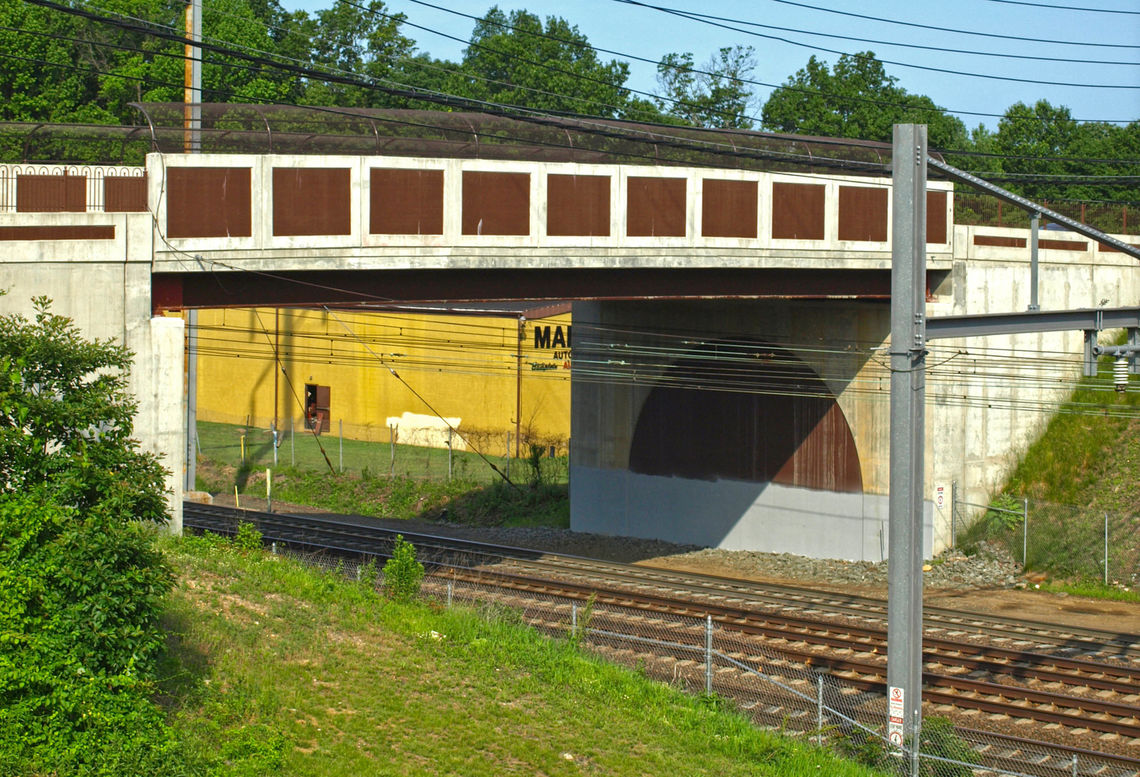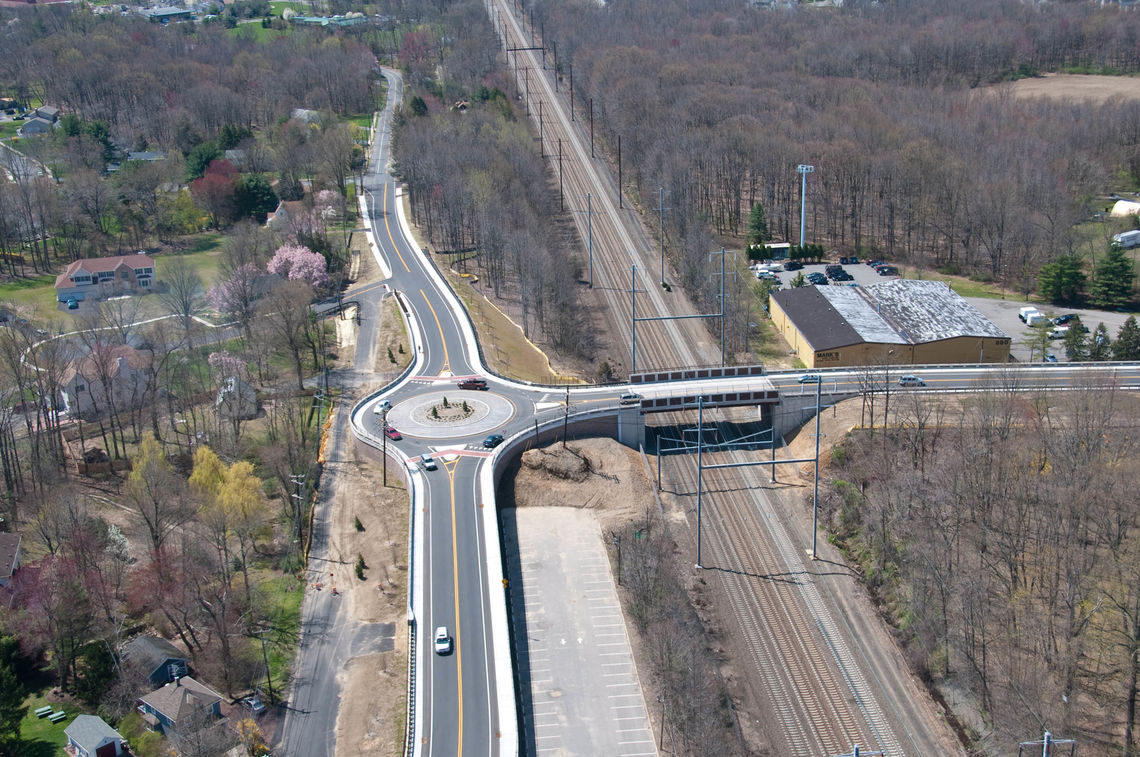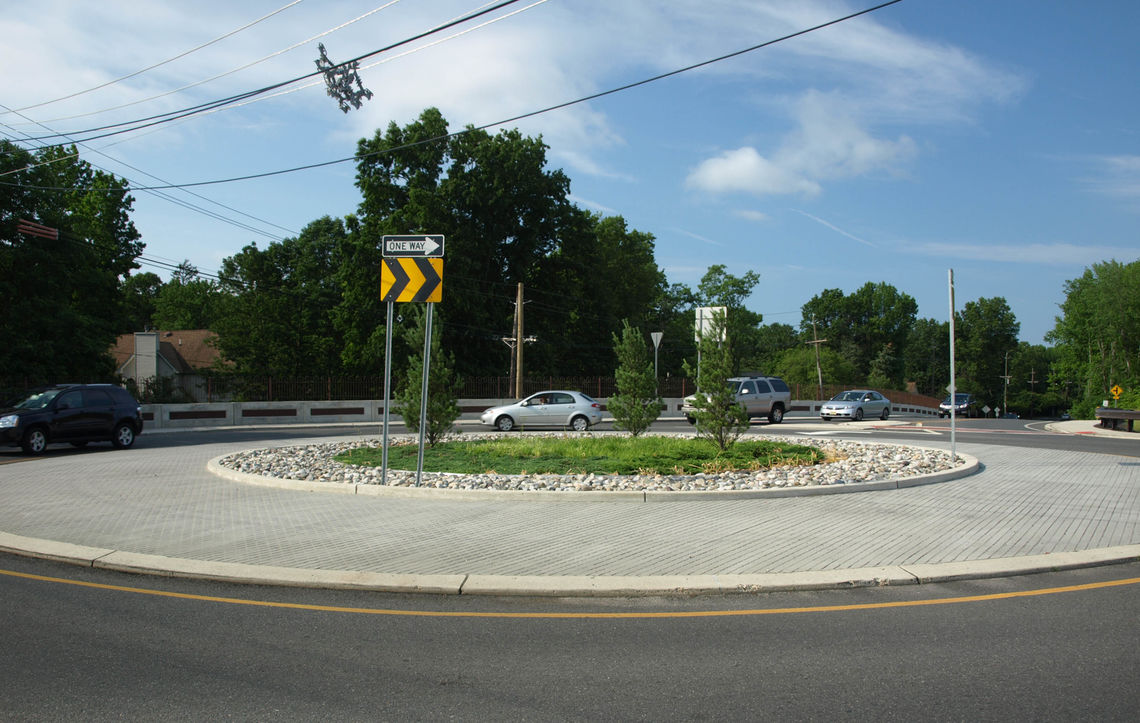Alexander Road over Amtrak

"The Alexander Road project [has] improved motorist and pedestrian safety and decreased congestion by replacing the existing, outmoded bridge and intersection with a more efficient modern roundabout and a new steel bridge complemented by sidewalks and shoulders. The improvements will benefit those traveling to and from nearby Princeton Junction Train Station"
-Former NJDOT Commissioner Kolluri
Alexander Road Over Amtrak, West Windsor, Mercer County, NJ
Safe and Smart Replacement
The original Alexander Road bridge was a deteriorated, 146 ft.-long, three-span structure built in 1941, that traversed four Amtrak Northeast Corridor (NEC) electrified tracks. The 20-foot bridge roadway width did not meet minimum design standards due to its poor vertical sight distances on both approaches, substandard lane widths on the bridge deck, and substandard horizontal and vertical railroad clearances.
The project was further complicated by a dangerous stop-controlled “T” intersection at Alexander Road and North Post Road. NJDOT sought to construct a new bridge on an adjacent alignment, improve traffic circulation and safety, minimize traffic disruptions during construction, minimize right-of-way impacts, and provide an aesthetically pleasing solution consistent with its Smart Solutions doctrine.
A Balance Approach Makes Progress
Urban provided fair compromise between replacing a structurally deficient and functionally obsolete bridge with preserving and respecting the context of West Windsor’s community setting. The project achieved consensus through collaboration. Agency and community relations activities were integrated into every phase of the project and contributed to its success. This was accomplished by delivering a consistent message throughout the project, facilitating creative solutions with partners, and providing design details and solutions that incorporate the community context.
We were responsible for preliminary and final design of the bridge's aesthetic, functional, and safety improvements, including improved substandard horizontal and vertical geometry along Alexander and North Post Roads (two municipal roadways), adding shoulders on all bridge approaches, providing a suitable cross-section and sidewalk for bicycle and pedestrian compatibility, and developing an AASHTO-compliant modern roundabout, joining the existing non-signalized intersection of Alexander and North Post Roads.
From our discussions with the community, maintaining the look and feel of other structures within the surrounding areas was important. Therefore, the project employed Smart Growth practices and used appropriate Context-Sensitive Design (CSD) elements to make the project blend with the community, motorists, and pedestrians. Pedestrian accommodations were also key to allow area residents easy access to the Princeton Junction Train Station, which is in close proximity to the Alexander Road Bridge.
Complex Constraints for a Complex Endeavor
A significant number of difficult issues presenting themselves had to be overcome during the project. For example, all work adjacent to the Northeast Corridor required approval of detailed Site Specific Work Plans (SSWPs) for track outages. SSWPs were developed for construction of the new bridge, removal of the existing bridge, construction of the new catenary structure, and re-profiling of the transmission lines (including extensions to existing transmission poles).
Required demolition and new construction had to occur without interfering with electrified transmission lines above the bridges or electrified catenary lines below them. Amtrak electric traction work for the railways below the bridge made it so that completion of the project was required within a very limited window of time.
Additionally, because of the work traffic in the West Windsor Parking Authority Parking Lot, construction could only be performed during the summer months in 2006.
Finally, requirements relating to various utilities presented more constraints, including:
- Water – All work had to be completed prior to construction (four months).
- PSE&G gas – Second Phase tie-in of the gas line could not be completed until North Post Road subgrade had been achieved. Gas line had to be relocated prior to removal of the existing bridge.
- PSE&G electric, MCI, Comcast – Temporary pole placement was completed prior to construction. Permanent pole placement was completed in Phase 2 or 3.
- Verizon – As Verizon’s lines were embedded in the existing bridge, telephone lines needed to be relocated prior to removal of the bridge.
Additional innovative approaches included:
- Use of an advanced utility contract to directionally drill a single casing beneath the Northeast Corridor without interrupting rail service. This casing was used to relocate water and gas lines that had been attached to the existing bridge.
- Construction of the new bridge and removal of the existing bridge without interfering with existing electrified catenary lines (below the bridges) and existing electrified transmission lines (above the bridges). This required thorough constructability reviews during design, detailed erection drawings, and extensive agency coordination.
- Work over the Northeast Corridor, such as construction of the new bridge and removal of the existing superstructure, required extensive coordination with Amtrak and NJ Transit. The coordination resulted in approval to temporarily de-energize the catenary lines on an off-peak weekend schedule. The de-energized catenary lines remained in place, while both Amtrak and NJ Transit used diesel trains to continue rail service.
Utility coordination, in accordance with the NJ State Utility Accommodation Policy, included aerial electric, telephone, and cable TV; and underground gas, water, sewer, and four fiber optic communication facilities within Amtrak right-of-way. The electrification facilities at the Alexander Bridge location (12 wires above, seven wires below, and four systems attached to the bridge) required re-profiling and re-support of the existing catenary system.
This project utilized InRoads 8.1 and Microstation 7.1 design software and was designed in accordance with the NJDOT Design Manual, Roadway; AASHTO LRFD Bridge Design Specifications; and AASHTO Roadway Design Standards. This project followed NJDOT’s Pipeline II Project Delivery Process and used the NJDOT Procedures Manual, CADD Standards Manual, and current applicable BDCs.
A Vital Link is Safe Again
The final product incorporated innovative design and construction methodologies rich in Context Sensitive design, including integrated solutions that properly meshed with the West Windsor Master Plan.
- Reduced span length from 146 ft. to an 86 ft. single-span, structural steel, rolled beams, HPC concrete deck, and pile-supported reinforced concrete abutments.
- Modern Roundabout – One of the first applications of a modern roundabout by NJDOT. Replaced the stop-controlled “T “intersection. Included wider lanes and shoulders, and improved horizontal alignment at the North Post Road/Wallace Road intersection. Various aesthetic treatments were used in the roundabout vicinity. The inner core of the roundabout was landscaped with dense shrubs and pruned columnar trees. The next ring around the landscaped core featured riverjack stone. The outer circumference of the roundabout is a gray cobble-stone, textured, colorized, stamped, asphalt treatment. This outer circumference is lined with aluminum edging to complete the aesthetics of the roundabout.
- Retaining Walls – Used instead of slope construction to minimize impacts to neighbors. Colors and patterns were selected through community consensus.
- Pedestrian and Transit Amenities – Additional sidewalks, two frontage roads for local use only (separates commuter traffic from residences). Pedestrian crossings in the roundabout vicinity were completed with a brick pattern, colorized, stamped, asphalt treatment.
- Fencing and Guiderail – Fencing and guiderail materials within the project were treated with a brown powder coating to match the guiderail in color.
Urban managed the project in a skillful manner, exceeding NJDOT’s expectations, resulting in a project that was delivered ahead of schedule, within budget and fully supported by the community. Improvements were achieved without disruption to NEC service and without interfering with electrified transmission lines above the bridges or electrified catenary lines below them. The ability to accurately estimate costs and schedule construction with consideration of prevailing market conditions and project constraints was an essential component in the success of this project.


